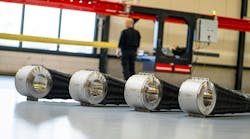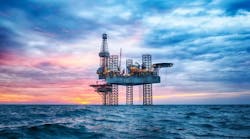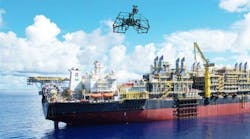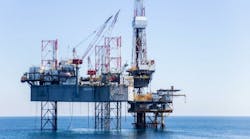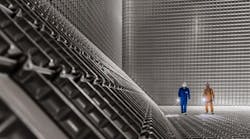This summer, two of the world’s more novel floating production platforms arrived in Rotterdam for modification work. Both programs are being handled by Keppel Verolme, a wholly-owned subsidiary of Keppel Offshore and Marine in Singapore.
First to arrive was the Sevan Stabilized PlatformSSP Piranema, which has been contracted to work for Petrobras under an 11-year charter, starting this fall. According to Keppel Verolme, this will be the first light crude production platform in operation off the coast of Brazil.
Shortly after contract award, the SSP designer Sevan Marine and Keppel Verolme began work on the project as an integrated team. Keppel Verolme is performing outfitting work, which includes the reception, temporary storing, pre-assembly, and installation on the hull of the process skids, pressure vessels, piping, and valves. Additionally, it is responsible for fabricating and installing steel structures, and hook-up of marine systems such as cranes, lifeboats, offloading systems, and fairleaders.
The innovative, circular 300,000 bbl FPSO was designed by Sevan Marine ASA, and built in China. It was then transported to Rotterdam on a heavy-lift cargo vessel for final completion and installation of the topside process and marine equipment by Keppel Verolme.
On arrival at the yard in Rozenburg on May 25, the platform was towed into the yard’s 500,000-metric ton drydock for outfitting works and topsides heavy-lift activities. Within three days a total of 1,500 metric tons of modules, packages, and equipment were installed successfully. On June 2, the platform was shifted to its final drydock position, allowing for further heavy-lift work and installation of the riser balcony and flare tower. The accommodation block also was completed.
The outfitting and completion scope include installation of all topside and marine equipment (i.e. cranes, lifeboats, offloading, and fairleaders); installation of all interconnecting piping; construction and installation of the riser balcony; completion of internal piping and marine systems; and paintwork, mechanical completion and commissioning.
Terra Nova turnaround
Petro-Canada (East Coast) had awarded Keppel Verolme a contract for the turnaround of theTerra Nova FPSO. The yard’s strategic location, facilities, experience, resource availability, project management, and safety track record all were factors in this award. Immediately after contract receipt, both companies established an integrated project team comprising personnel from Rozenburg and from St John’s, Newfoundland and Labrador, and subcontractors.
The vessel arrived safely at Keppel Verolme’s yard on July 5. It is scheduled to be delivered and re-deployed this September on the Terra Nova field, 350 km east southeast of St John’s.
The scope of work includes maintenance, inspection, and modification of the FPSO’s hull and process topsides systems. Installation of an additional living quarter module aft of the existing accommodation area will increase the vessel’s POB capacity.
Maintenance work includes survey and overhaul of thrusters, maintenance of underwater valves; coating of the hull; and various repairs to the vessel and process systems. Inspection and modification activity extends to testing of cargo tanks and pressure vessels, and modifications to the process modules.
Kepel Verolme’s shipyard spans over 54 ha in Rotterdam’s Botlek area. It includes three drydocks, and the 90-m wide graving dock with deepwater frontage is said to be Europe’s largest. The company also repairs and converts some of the world’s largest semisubmersibles.
Currently it is upgrading theBlackford Dolphin. The program includes fabrication of new lower and upper hull structures and modules. This work is designed to extend the operating life-span of the rig, built originally in 1974 as the Ocean Liberator. The yard also is upgrading a Sedco 700 series semi for Transocean, due for delivery next May. Work in this case includes converting the vessel for full dynamic positioning capability, and to perform drilling, completions and workovers in more than 2,000 m of water in moderate environments.



